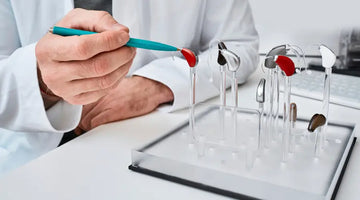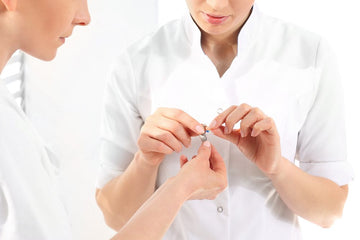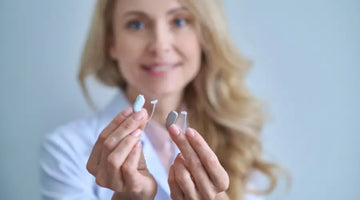Ever wonder why your hearing aids sound muffled at times or stop working? I’ll tell you—it’s likely because they need a good cleaning! Learning how to clean hearing aids correctly isn’t just about keeping them shiny; it’s about protecting your health and prolonging their life span. If you do not clean them, earwax can block the tiny components, moisture can damage the electronics, and bacteria could even lead to infections. I’ve seen it happen!
But fear not — I’ll show you the simple daily steps that will help your devices continue to work like new. Wiping them down, using the right tools (such as a soft brush or drying kit), and checking for wax buildup can help prevent expensive repairs and more transparent sounds on a daily basis.
The Big Three Factors That Affect Hearing Aids
1. Humidity
Humidity is one of the leading threats to hearing aids. Excess moisture can seep into the device and damage the sensitive electronic components, leading to malfunctions or reduced volume clarity. Even sweat caused by daily activities can contribute to increased moisture levels in your hearing aids. To protect your devices, it’s crucial to use a dehumidification system or store them in a dry environment overnight. Specialized hearing aid drying boxes are a great investment to combat moisture issues.
2. Bacteria
Bacteria may not be visible to the naked eye, but it can easily build up on your hearing aids over time. Regular handling, sweating, and day-to-day exposure to the environment can transfer germs to your devices. This buildup can potentially cause ear infections, irritation, or harm to your ears. To prevent this, be vigilant about disinfecting your hearing aids using alcohol-free cleaning wipes or dedicated hearing aid cleaning sprays. These tools are specifically designed to keep bacteria at bay without damaging delicate materials.
3. Earwax
Earwax (or cerumen) is the natural nemesis of any hearing aid. It frequently accumulates on microphones, sound ports, and tubing, which can muffle sound or block performance altogether. Cleaning the earwax off your devices should be part of your daily maintenance routine. Use a cleaning brush or pick to gently remove wax, being cautious not to scratch or push debris further into the hearing aid. Many hearing aids even have a wax guard that can be replaced to enhance their longevity.
Essential Tools and Supplies for Cleaning Hearing Aids
Let’s look at some cleaning tools to keep your hearing aids working well.
Must-Have Cleaning Tools
These are the basics for your hearing aid maintenance kit:
● Wax pick: A tiny scoop to gently remove earwax from small holes.
● Soft brush: Cleans dirt without scratching your hearing aids.
● Drying container: A safe box to remove moisture overnight.
● Disinfecting wipes: Special wipes that kill germs (don’t use water!).
Remember: Avoid regular cleaners like alcohol or hydrogen peroxide. They can break your hearing aids!
Optional but Helpful Accessories
Want to make cleaning easier? Try these extras:
● UV sanitisers: A flashlight-like tool that zaps germs with light.
● Air blower: Blows dust out of tiny spaces (like a mini fan!).
● Wax guards: Little filters that catch earwax before it gets inside.
You don’t need these, but they help if your hearing aids get dirty often.
How to Clean Different Types of Hearing Aids
Each hearing aid style requires a slightly different cleaning method. Below, we’ll cover how to clean three popular types of hearing aids effectively.

How to Clean Receiver-in-Canal (RIC) Hearing Aids
Receiver-in-canal (RIC) hearing aids are small and discreet, but their design makes them prone to wax and debris accumulation. Here’s how to clean them properly:
- Remove the Dome: If your RIC hearing aid has a removable dome, carefully take it off. Clean the dome with a soft cloth or replace it if necessary.
- Clean the Receiver: Use a wax guard or brush to gently remove debris from the receiver. Avoid pushing wax deeper into the device.
- Check the Tubing: Inspect the thin tubing for any blockages, and use a cleaning wire to clear them out gently.
- Wipe the Exterior: Finish by wiping down the entire device with a lint-free, alcohol-free cleaning cloth.
- Dry the Hearing Aids: Use a hearing aid drying box or a dehumidifier to remove any moisture from the device.
How to Clean In-the-Ear (ITE) Hearing Aids
Because in-the-ear hearing aids sit entirely in your ear canal, they are especially susceptible to wax and moisture buildup. Follow these steps for proper care:

- Inspect the Vent: Use a small cleaning tool to gently clear out the vent of any wax or debris.
- Wipe the Shell: Use a soft cleaning cloth to wipe the outer shell. Be sure not to press on the microphone openings.
- Remove Wax: Apply a wax guard or pick to remove any buildup around the microphone or receiver ports.
- Dry Thoroughly: If moisture is present, consider using a dehumidifier to help remove it quickly.
How to Clean On-the-Ear (OTE) Hearing Aids
On-the-ear (OTE) hearing aids typically have tubing and earmolds that require regular cleaning. Here’s what you need to do:
- Remove the Dome: Gently detach the dome from the hearing aid.
- Clean the Shell: Use a soft cloth or cleaning wipe to clean the outer shell of the device.
- Remove Wax: Use a wax removal tool to clear any buildup from the openings.
- Dry the Hearing Aids: Ensure the hearing aids are completely dry before reassembling or using them.
Remember: Do this daily cleaning routine every night before bed. Your hearing aids will thank you with clear sound!
Easy Tips and Timings To Keep Your Hearing Aids Clean
You’ve learned how to clean them—now let’s talk about keeping them clean! Just like brushing your teeth every day, hearing aids need regular care.
How Often Should You Clean Your Hearing Aids?
Cleaning frequency means doing small tasks daily and bigger ones weekly. Every morning, wipe the outside with a dry cloth. At night, use your soft brush to remove earwax from the tiny holes. Once a week, give them a “bath” in the drying container overnight. This stops dirt from building up and keeps the sound clear.
Stopping Wetness and Germs
Moisture prevention is super important! After cleaning, always put your hearing aids in the drying container (it’s like a cozy bed that sucks out wetness). Keep them away from bathrooms or kitchens where steam lives. If you sweat a lot, wipe them with a disinfecting wipe once a day. Never wear them in the pool or shower—water is their enemy!Quick Tip: If your hearing aids get wet, don’t use a hairdryer! Put them in the drying container right away.
When Your Hearing Aids Need a Doctor
Even if you clean them every day, sometimes hearing aids get sick! Here’s how to know when to call a hearing expert.
Strange Sounds or Broken Parts? Time for Help!
If voices sound fuzzy (like a robot talking), that’s distorted sound—tell an adult! Hearing aids that whistle nonstop (persistent feedback) need hearing aid repair, even after you clean them. See cracks, holes, or loose wires? That’s visible damage. Don’t try to fix it yourself—experts have special tools!
💡 Remember: “Take your hearing aids for a professional cleaning every 3-6 months. The doctor checks for icky mold hiding inside!”
FAQs
1. Can I Use Alcohol Wipes on Hearing Aids?
Nope! Alcohol wipes can melt the tiny parts inside. Use special disinfecting wipes made just for hearing aids. If you use alcohol, it might crack the plastic or make germs stick harder!
2. Can I Put My Hearing Aids in Water?
Never! Water breaks hearing aids like a dropped ice cream cone. If they get wet, dry them fast with a soft cloth and put them in a drying container overnight. Do not swim or shower with them!
3. How Do I Clean Hearing Aid Batteries?
Take the battery out first! Wipe the metal part with a dry cloth. Never touch the battery with wet hands—it can stop working. Let it air-dry for 1 minute before putting it back.
4. How to Clean Them Without Breaking Them?
Use your soft brush to sweep away earwax. Wipe the outside with a dry cloth (like cleaning glasses). Do not use soap, water, or sprays! If something’s stuck, ask a grown-up for help.
Conclusion
Think of cleaning your hearing aids like brushing your teeth—skip it, and things get messy fast! When you master how to clean hearing aids every day, you stop earwax from clogging the sound and keep moisture from breaking the tiny parts inside. No more muffled voices or sudden silence!
A quick wipe with a dry cloth or a nightly brush-down takes less time than tying your shoes. And guess what? Your hearing aids will work better and last years longer. If you ever forget a step, just come back to this guide.
📌 Bookmark this page now—your future self will thank you when your hearing aids stay clear and strong!




